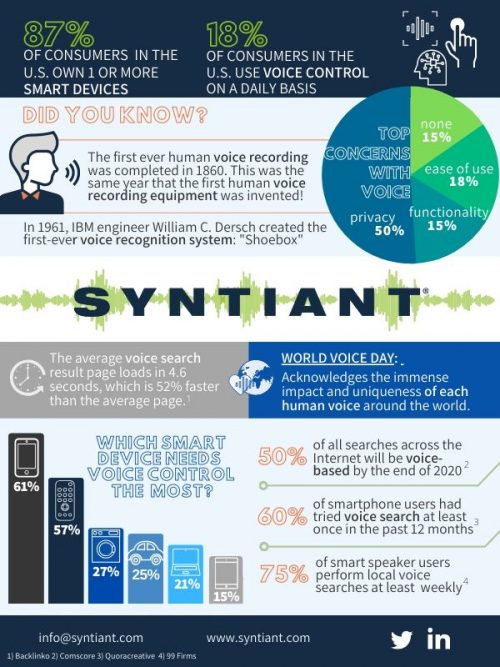Over half of Americans feel voice control is essential in smart devices
Thursday, May 14th, 2020More than Half of Americans, Including Majority of Young Adults, Feel Voice Control Is Essential in Smart Devices Post COVID-19, Survey Reveals
- Hands-free Smartphones and TV Remotes Rank Highest Priority, As Consumers Opt for Voice Interfaces in Hopes of Reducing Exposure
- Backed by Amazon, Bosch, Intel and Microsoft, Syntiant Sees Enormous Growth Potential in the Always-On Voice Market
IRVINE, Calif. — As consumers find new ways to connect with family, friends and colleagues during COVID-19, a majority of Americans are opting to use their voices to control a variety of smart devices, rather than using touch screens and other tactile interfaces, according to results from a national CARAVAN® survey conducted on behalf of Syntiant, a deep learning tech company providing always-on voice solutions for edge devices.

At-a-Glance:
- 87 percent of Americans own one or more smart devices.
- Generation Z is most likely to increase their speech control usage due to the coronavirus.
- 81 percent of Gen Z and Millennials report using voice control, compared to 68 percent of Generation X and 51 percent of Baby Boomers.
- Consumers rank smartphones, smart TV’s/remotes and home appliances as the top three smart devices needing voice control.
- Half of all Americans say privacy and security are their top concerns.
Voice Control in Smart and IoT Devices
Consumers rank smartphones (61 percent) and smart TV’s/remotes (45 percent) among the most important devices to include voice control. Additionally, 27 percent of survey respondents select smart home appliances (thermostats, doorbells, microwaves, etc.) to round off their top three choices, primarily driven by Generation X and Baby Boomers. Generation Z and Millennials, in turn, prefer their gaming devices and smartwatches to have voice control (28 percent and 18 percent, respectively).
“Voice is quickly becoming the next user interface,” said Kurt Busch, CEO of Syntiant. “Our survey found that more than two thirds of Americans are using voice to control their devices, which is indicative of our own customer growth, and the growing market opportunity for our hands-free, always-on voice solution. Whether it’s using customized multi-lingual wake words, or speech commands, such as ‘volume up’ or ‘volume down,’ our Neural Decision Processors deliver voice technology that is creating rewarding experiences at the edge, empowering consumers to use speech to seamlessly command their smart products.”
Voice Control in the Future
As the world embraces the fallout of COVID-19, lasting effects from the pandemic indicate consumers will opt for voice user experiences and hands-free interfaces, with Gen Z being most likely to increase speech control usage (60 percent) in smart devices, followed by Millennials (56 percent), Gen X (54 percent) and finally, Baby Boomers (43 percent).
Not surprising with any new technology, concerns remain, as more consumers switch from tactile interfaces, such as touch screens, to hands-free functionality. While 15 percent of Americans say they do not have any concerns with voice control, 27 percent say privacy tops the list, followed by security (23 percent), functionality (19 percent) and ease of use (15 percent).
“It’s clear that the current pandemic is driving demand for voice control, as people refrain from touching their devices in hopes of reducing health risks,” added Busch. “Further adoption of voice user experiences will continue to grow among various demographics as AI technology becomes more pervasive at the local level. Advances in voice technology result in enhanced privacy in smart devices by not requiring a cloud connection and power consumption levels that are orders of magnitude lower than ever before. Syntiant’s solution puts deep learning into almost any edge device, with highly accurate wake word and command control, enabling consumers to use their devices with speech that is secure and private.”
About the Survey
The online omnibus survey was conducted April 22-24, 2020 by Engine Insights among a statistically viable population of adults 18 years of age and older, weighted by age, gender, geographic region, race and education. Generations defined as: Generation Z (ages 18-23), Millennials (ages 24-39), Generation X (ages 40-55) and Baby Boomers (ages 56-74).
Latest News
- Tata Motors selects HARMAN Automotive's in-vehicle app store
- Media Distillery to power Swisscom ad-free replay product
- MagentaTV strengthens addressable TV business with Equativ
- Deutsche Telekom selects Broadpeak Cloud DVR solution for MagentaTV
- Nexxen empowers Australian advertisers using VIDAA ACR data
- TargetVideo integrates AI for video content categorization